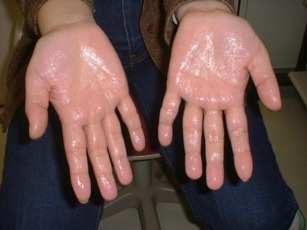Hyperhidrosis - treatment, symptoms and causes

Hyperhidrosis is Excessive sweating that results from abnormal functioning of the nerves or BLOOD vessels that supply the eccrine SWEAT GLANDS. Hyperhidrosis characteristically involves the hands (palms), feet (soles), and axillae (underarms), though can affect eccrine sweat glands anywhere in the body. The eccrine sweat glands produce most of the body’s sweat and play a key role in thermoregulation (regulating body heat). They empty their fluids (perspiration) directly to the SKIN’s surface for rapid evaporation and cooling.
Hyperhidrosis Causes
Stress and physical activity tend to exacerbate hyperhidrosis, particularly when it affects primarily the hands and feet. The portion of the BRAIN that regulates sweating in these areas, the cerebral cortex, is not part of the body’s thermoregulation system but rather responds to emotional signals such as anxiety and fear. Hyperhidrosis may also occur as an undesired SIDE EFFECT of medications or a symptom of metabolic disorders such as HYPERTHYROIDISM and DIABETES, or health conditions such as TUBERCULOSIS and Hodgkin’s LYMPHOMA. Most hyperhidrosis that arises from structural or functional anomalies of the nerves or blood vessels first appears in ADOLESCENCE, when the hormonal changes of PUBERTY stimulate sweat gland function. Hyperhidrosis that begins later in life generally arises from underlying health conditions.
Symptoms of Hyperhidrosis and Diagnostic Path
The primary symptom of hyperhidrosis is profusely excessive sweating. The hands and feet, when involved, may be continually wet. Sweating from the underarms and other areas of the body typically drenches clothing, requiring frequent clothing changes. The diagnostic path typically includes a comprehensive NEUROLOGIC EXAMINATION and blood tests to measure HORMONE levels. The doctor may conduct further diagnostic procedures, depending on the individual’s health circumstances.
Hyperhidrosis Treatment Options and Outlook
Treatment options currently available in the United States include topical products, oral medications, BOTULINUM THERAPY, iontophoresis, and, when other treatments are unsuccessful, surgery.
- Topical products block the pores of the sweat glands. Those commonly used include aluminum chloride preparations, boric or tannic acid solutions, glutaraldehyde, and potassium permanganate. These products may stain the skin and clothing. Most people apply them at night and wash them off in the morning.
- Oral medications interrupt the action of the nerves that regulate sweat gland activity. Those commonly used are anticholinergics such as propantheline and benztropine, which block the action of the NEUROTRANSMITTER acetylcholine. Dermatologists sometimes prescribe other medications such as beta-blockers and calcium channel blockers. These medications may have unacceptable side effects, however, and they are not approved for this use in the United States.
- Iontophoresis uses mild electrical current in a water-based solution to shrink the sweat gland pores and is a treatment option for hyperhidrosis of the hands and feet. Relief generally requires daily treatments over a period of several weeks.
- Botulinum therapy (localized injection of purified botulinum toxin) blocks acetylcholine, interrupting the flow of NERVE signals to the muscles that contract to push fluid from the sweat glands. The effect can last for six months or longer.
- Surgery to sever some of the nerves supplying the sweat glands, or to remove clusters of sweat glands such as in the axillae, is a treatment of last resort for severe hyperhidrosis that does not respond to other treatments. The effects are permanent.
Many people who have hyperhidrosis use combinations of these approaches to control their symptoms. Hyperhidrosis is often deeply embarrassing to those who have it, particularly adolescents. Because stress plays a key role in hyperhidrosis, stress management techniques are often helpful for coping with the condition as well as reducing the stimuli that exacerbate symptoms.
Hyperhidrosis Risk Factors and Preventive Measures
When an underlying health condition is the cause of the hyperhidrosis, treating the condition eliminates the hyperhidrosis. Primary hyperhidrosis is a lifelong condition for which there are no known risk factors or preventive measures.
See also OFF-LABEL USE; STRESS AND STRESS MANAGEMENT; TINEA INFECTIONS.